Episodes
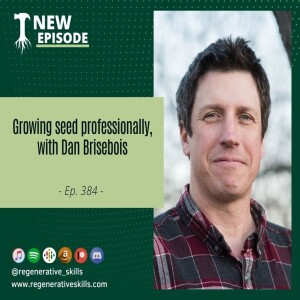
Saturday Jun 21, 2025
Saturday Jun 21, 2025
I’ve explored the topic of seed saving and breeding a number of times in previous episodes and it’s become such a passion of mine that it’s the primary focus of my early work here on my own farm as I begin to get the main patterns and infrastructure developed. A new angle of this subject however is the more direct and professional operation of producing seed to sell. This requires even more planning and coordination as each plant has its own peculiarities of reproduction and conditions for harvest, processing, and preservation. Luckily I’ve got a seasoned veteran of seed production to illuminate the key considerations and preparations to build a successful seed production enterprise, including on top of an existing market garden.
In this conversation I’ve got Dan Brisebois, a seasoned cooperative farmer, to discuss the various aspects of seed farming, from his own slow start in the beginning, to the present day success of his enterprise that was founded in 2004. He starts by touching on his background and his shift from agricultural engineering to farming, driven by a passion discovered during summer farm work. Dan elaborates on his cooperative farm’s structure, which has expanded to include 11 members and 9 member applicants. He then delves into his journey of integrating seed production into his market gardening enterprise, spurred by encounters with seed enthusiasts and the fascination with cross-pollination and plant breeding. Dan also shares practical insights on the equipment, processes, and considerations for seed harvesting, cleaning, and storage, emphasizing the importance of knowledge over technological sophistication. He explains his labeling and tracking system for plant breeding and offers advice on balancing genetic diversity with achieving true-to-type consistency. Furthermore, Dan reflects on the unexpected discoveries and rewarding moments in plant breeding and highlights the profitability factors when growing seeds for bulk versus small packets. Lastly, Dan touches on the impact of market demand for specialty seeds and advises aspiring seed growers on where to get started, mentioning his book, podcast, and additional resources provided through his Farmer Spreadsheet Academy.For those of you like me, passionate about the unlimited potential of working with seed, or who perhaps already have a garden or market veggie production enterprise and might want to add some additional value to what you’re already growing, this will be a great episode for you.
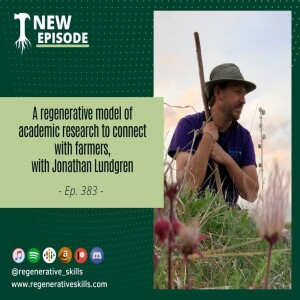
Friday Jun 13, 2025
Friday Jun 13, 2025
There often seems to be an unfortunate disconnect between farmers in the field and the researchers and academics involved with agronomic study. I often hear in the discussions in the climate farmers community about how academic studies don’t reflect the reality in the field, or that the ivory tower of academia is out of touch with the farms and situations they study. As I've made more connections in universities and research programs, I find that academics are aware of this too and are concerned about this lack of communication and the barriers between these sections of the industry that should be in closer collaboration. I’ve often wondered what an integrally connected research sector and farm culture could look like. Would researchers be a regular presence in the field and rural communities with close friendships and collaborations with farm owners and workers alike? Would this mean more farmers conducting their own studies and experiments and sharing the findings with universities and peers as they receive guidance and recognition for their contributions?Maybe a journeyman farmer trade apprenticeship could include research and experimentation training as well as communications of findings and a more holistic approach to farm study.The good news is that many of these ideas are not that far fetched and are being explored in various ways by Dr. Jonathan Lundgren who is an agroecologist, beekeeper, farmer, Executive Director of Ecdysis Foundation, and CEO for Blue Dasher Farm. Lundgren’s research and education programs are helping applied science evolve in ways that foster the evolution of a regenerative food system. He regularly interacts with the public and farmers around the world regarding ecologically intensive farming and how biodiversity fuels the resilience and productivity of an agroecosystem and rural communities.In this episode Jonathan shares his journey from being a suburban biology enthusiast turned USDA scientist, to becoming a farmer and regenerative scientific researcher. We discuss the challenges and successes of managing a diverse farm at Blue Dasher Farm, which integrates native prairie, wetlands, and various crops and animals. Jonathan emphasizes the importance of biodiversity, community, and the limitations of conventional scientific metrics in truly understanding and enhancing agricultural systems. He also describes his innovative approaches to research, focusing on real-world data collection from thousands of farms, and advocating for a more relational and context-specific approach to both farming and science.
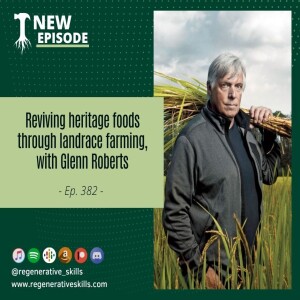
Saturday Jun 07, 2025
Saturday Jun 07, 2025
Join Oliver on Regenerative Skills as he interviews Glenn Roberts of Anson Mills, exploring the revival of heritage cultivars like Carolina Gold Rice. Discover how deep-rooted, sustainable agricultural practices and community engagement are transforming the modern food system. Learn about the importance of landrace genetics, polyculture, and the potential of crops to adapt to climate change. Glenn shares his journey, the influence of early mentors, and how chefs and local communities are embracing this movement towards more resilient and flavorful food.
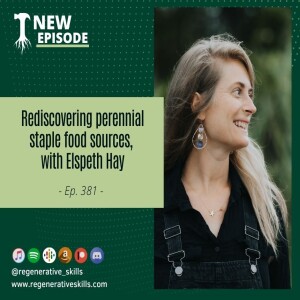
Friday May 30, 2025
Friday May 30, 2025
As I continue to advance the tree and perennial food nursery here at my farm, I’m always on the lookout for new resources on anything about growing and breeding perennial food sources, the history of their cultivation, and the cultures that were and are connected to these woodland and orchard based staple foods. For that reason I was super excited to see the new title “Feed us with Trees” from my friends at New Society Publishers, by author Elspeth Hay.
Elspeth is a writer, public radio host, and creator of the Local Food Report, a weekly feature that has aired on CAI, the Cape & Islands NPR Station, since 2008. Deeply immersed in her own local food system, she writes and reports for print, radio, and online media with a focus on food and the environment. Elspeth’s work has been featured in the Boston Globe, NPR’s Kitchen Window, Heated with Mark Bittman, The Provincetown Independent, and numerous other publications. Through her conversations with growers, harvesters, processors, cooks, policy makers, Indigenous knowledge-keepers, scientists, researchers, and visionaries, she aims to rebuild our cultural store of culinary knowledge—and to reconnect us with the people, places, and ideas that feed us.
In this session, Elspeth shares her journey of developing a passion for perennial food systems, particularly focusing on nuts and tree-based staple crops.
Her early exposure to nature evolved into an obsession with acorns and other tree nuts. Her research went on to reveal the extensive use of tree nuts as staple foods across the northern hemisphere and the historical as well as the cultural shifts that led to their decline in favor of annual grain crops. Elspeth delves into the nutritional and ecological benefits of these perennial foods, the complexities of modern industrial agriculture, and the resurgence of interest in tree crops, especially in the American Midwest. She also explores innovative recipes and culinary uses of nuts, especially acorns and chestnuts, while emphasizing the importance of integrating perennial crop systems into modern diets and agricultural practices. This conversation covers a lot of ground from land management, economic models, and the promising future of perennial food systems.
As with all the books that I focus on from my friends at new society publishers, we’re running a book giveaway for “Feed us with Trees.” By now you know the drill. Send me a message on our Discord community. If you’re not already a member you can sign up through the links on our homepage or the bio on Instagram. I’ll choose a winner one week after this episode goes live, and If you live anywhere in North America we’ll send a physical copy. Everywhere else you’ll receive a digital version.
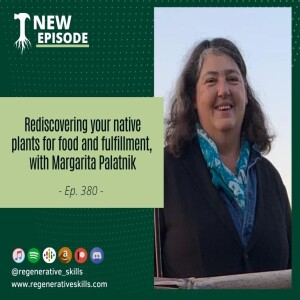
Friday May 23, 2025
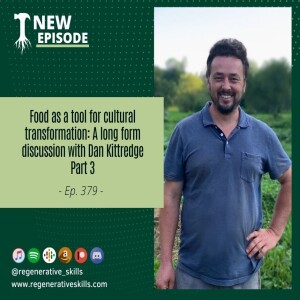
Friday May 16, 2025
Friday May 16, 2025
Welcome to the last portion of our long form discussion with Dan Kittredge.
In this last third we navigate the need for Generational Healing and Cultural Shifts in our collective culture. The unavoidable reality that the healthiest food for you as an individual can never be bought. Steps for building resilience and Self-Sufficiency, before then going back to Dan’s own Journey to Farming and interest in Nutrient Density as well as his current Challenges and plans for the future.
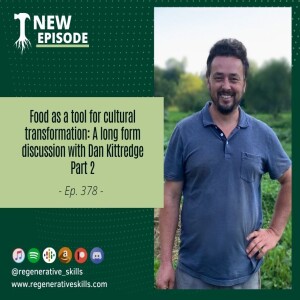
Friday May 09, 2025
Friday May 09, 2025
Today we’ll be continuing with the second portion of our long form discussion with Dan Kittredge. In this second third we mostly get into Principles of Biological Systems and how to apply Nature's Patterns in Business. Dan talks about his experience Engaging with Farmers and Large Businesses alike. We dig into his personal Journey, the influence that Eastern Paradigms and Consciousness have had on his world view, the connection of Nutrient Density and Spirituality, and the potential of Technological Tools to be transformed for Empowerment.
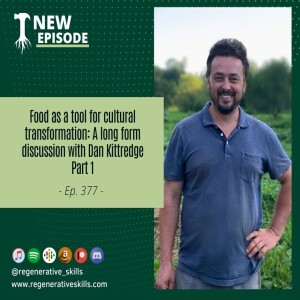
Friday May 02, 2025
Friday May 02, 2025
One of the discussions that have propelled the awareness of regenerative agriculture in recent years has been that of nutrient density in food, a term coined by Dan Kittredge of the Bionutrient Food Association. The idea that our food varies widely in its quality and levels of nutrients has caused many people to look into the factors that lead to these wide discrepancies. Dan in particular has been leading research, one ingredient at a time, into the causes and correlations that accompany differences in levels of vitamins, minerals, fats, proteins and almost every other known component in the food we eat.
Though I’ve been watching the conversation and developments of this concept and research for years now, I have been waiting to build a decent enough grasp of the topic to be able to guide a meaningful conversation about what has been learned, where the research is going, and what are the potential pitfalls or opportunities for corruption of knowledge and technology that tells us the details of the nutrients in every ingredient we consume.
Then a few weeks ago, my good friend Andre Antunes in Portugal introduced me directly to Dan Kittredge through email urging us to connect and have a conversation. I know that Dan does interviews all the time and so I asked him what he would want to talk about that he often doesn’t get to explore. He got back to me by saying he’d be most interested in doing a long form discussion in which we have the time to discuss all of the concepts and ideas around the core of his work with the Bionutrient Food Association that both inform the purpose and research but that go into the bigger motivations and theory behind it all…so, that’s exactly what we did. Earlier this week Dan and I set aside time to really leave the space open and see where the chat could end up. Almost two and a half hours later, time which absolutely flew by for me, I have a deep dive for you that explores all that I mentioned and more. Given that I don’t tend to do long form conversations, I’ve broken things down into three 45ish minute episodes. If however you prefer to listen in all one uninterrupted go, I published the video version in its entirety on the regenerative skills YouTube channel.
In this first third you’ll hear us discuss Dan’s seven-month global tour focused on nutrient density, the importance of understanding its true definition, and its critical role in social movements turning into industries. He elaborates on the BFA's perspective, emphasizing that nutrient density is a continuum of quality rather than a binary concept. The conversation underscores the need for a universal standard of nutrient density, the correlation between soil health and nutrient levels, and the use of spectroscopy technology to measure and improve food quality
In the second third we mostly get into Principles of Biological Systems and how to apply Nature's Patterns in Business. Dan talks about his experience Engaging with Farmers and Large Businesses alike. We dig into his personal Journey, the influence that Eastern Paradigms and Consciousness have had on his world view, the connection of Nutrient Density and Spirituality, and the potential of Technological Tools to be transformed for Empowerment.
In the last third we navigate the need for Generational Healing and Cultural Shifts in our collective culture, the unavoidable reality that the healthiest food for you as an individual can never be bought. Steps for building resilience and Self-Sufficiency, before then going back to Dan’s own Journey to Farming and interest in Nutrient Density as well as his current Challenges and plans for the future.
The other two sections will come out on Friday in the next two weeks, which actually suits me really well because I’m just getting ready to leave for a water restoration job in La Mancha here in Spain and then to the University of Reading to start a Regen Ag transition and agronomist training that I’ll be building with a diverse team, all of which I’ll tell you about in future episodes.
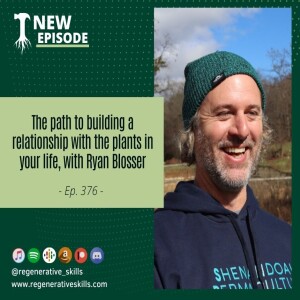
Friday Apr 25, 2025
Friday Apr 25, 2025
In so many previous episodes I’ve spoken with people who’ve explained many nuances and facts about plants and how to incorporate different species of trees, shrubs, grasses, and forbes into your ecosystem. How to manage them in different stages of growth either through active cultivation and soil condition improvement or secondarily through the management of animals or other elements of the human built world, but in this interview we’re going to take a different approach to the vegetal world and consider a beautiful and often overlooked aspect of our connection with plants, and that’s the possibility of creating relationships with them. If that concept seems weird to you, consider that people in all parts of the world all throughout history have cultivated deep interconnected relationships with plants of all kinds. There are connections that heal us, show us our location, signal different soil conditions, nourish, clothe, and protect us. Many cultures reference being able to speak to plants and communicate with them. They can open our consciousness to different states of being and thinking as well, and not only through psychotropic properties.
In this episode I spoke with Ryan Blosser, the co-author along with Trevor Piersol of the new book Mulberries in the Rain: Growing Permaculture Plants for Food and Friendship. The book goes beyond the sphere of most permaculture books that are heavy on design theory and techniques, and speaks about the process of investigation and time investment to build lasting and mutually beneficial relationships with the plants that you cultivate, forage or otherwise cohabitate with. Ryan is also co owner and lead instructor with Shenandoah Permaculture Institute. He is also the Farm Educator with Waynesboro City Schools where he runs Waynesboro Education Farm and is also a former child and family therapist and market farmer.Besides covering practical steps for building a relationship with the plants you come into contact with, much more than other episodes, this conversation is based on stories, both Ryan’s and my own. We talk about adversarial relationships with plants that blossomed into alliances. We trade memories of plant that ground us in place and are connected with who we perceive ourselves to be. Ones that are connected to family, legend and legacy as well as a few we’re still reconciling and exploring but present challenges.
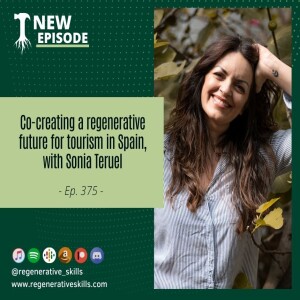
Saturday Apr 19, 2025
Saturday Apr 19, 2025
Today we’ll continue the miniseries I’m building on regenerative tourism. This time we’ll take a close look at the specific context of the country where I live, here in Spain. Spain has been a top global tourist destination since the 60s and the industry that as grown to meet the demand for travel as shaped so much of the country especially the Mediterranean coast and cities like Barcelona, Valencia, and towns that have grown up entirely to cater to a specific type of budget tourism like Benidorm, Salou, and Lloret del Mar.
Yet in recent years there has been a major backlash from the local population protesting irresponsible development, skyrocketing prices, and exemptions from water restrictions directly related to the way tourism is managed. Here to explore these challenges as well as the potential to chart a new course for both hosts and visitors is Sonia Teruel. Sonia helps grassroots initiatives, entrepreneurs and Destination Management Organisations in their transition to a regenerative model in tourism. She is also a consultant, facilitator, and founder at The RegenLAB for Travel. In this conversation we explore the meteoric rise of Spain as a tourist destination and its impact on the communities where visitors concentrate. We look at the challenges that have ignited protests and opposition to the way tourism is managed as well as some of the responses to these issues which may cause bigger problems in the long term. From there we mine Sonia’s experiences as a community conversation facilitator who works to guide collaborative processes that explore the potential for new ways of managing visitors and hosts alike in order to achieve lasting solutions.
Sonia will be the first to admit that these efforts are still in their infancy and case studies of real success over time don’t exist yet in our region, but points to some promising projects to keep an eye on and perhaps emulate as they get established. Though the focus is on the Spanish context, I have no doubt that there are equivalents to many other places around the world where the tourism industry has shaped development and policy for decades, and I hope many of you listening will find inspiration for where you live as well.









